St. Mark’s Basilica, built in the eleventh century, is the most famous and most recognizable of all the churches in the city of Venice. Its design mixes eastern and western building styles in a unique way.
Its History and Construction
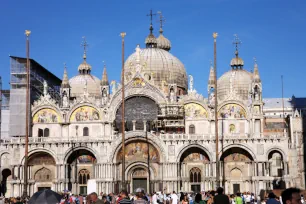
The original St. Mark’s Church was situated inside the complex of the Doge’s Palace and was constructed in 828. It was built to house the relics of St. Mark the Evangelist, which were supposedly stolen by Venetian merchants from Alexandria, Egypt several years earlier.
The church burned down in 976 during an uprising. It was rebuilt twice, the last time in 1063. At that time the power of the Venetian Republic had risen dramatically, and the new basilica, consecrated in 1094, would come to symbolize the republic’s growing power and wealth. This basilica is the one we see today. It was the doge’s private chapel until 1807, when it became the city’s cathedral.
Considered one of the best examples of Byzantine architecture in the world, the Basilica di San Marco is known for its opulent design and gilded interior mosaics, and nicknamed Chiesa d’Oro, “Church of Gold”. Its design is a mixture of eastern and western architecture styles, resulting in a unique architecture typical for Venice.
Exterior
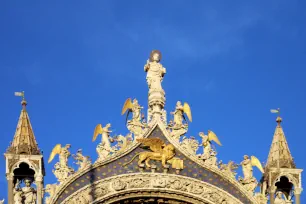
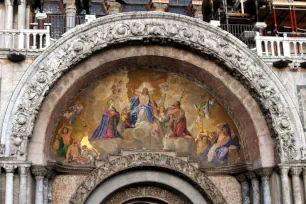
The exterior of the basilica is quite ornate and has been added to over the centuries. Historians note that whenever Venetian vessels returned from the Orient, they brought something for the basilica, be it a frieze, column, or something else from an ancient building elsewhere in the world.
Technically, the exterior is divided into three registers – lower, upper, and domes. The lower consists of five arched portals – the center one slightly larger – surrounded by marble columns. Large bronze doors lead into the narthex. Above the lateral portals are mosaics depicting the stories of St. Mark’s relics; the one on the left is the oldest one and depicts the St. Mark’s Basilica as it looked like in the middle of the twelfth century. The mosaics in the upper level arches depict stories from the life of Jesus;
the one above the main portal is the gilded mosaic known as “The Last Judgment”.
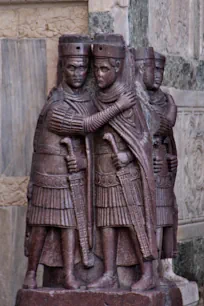
Above the large central window is the Winged Lion – symbol of Venice – and on the central balcony are statues of Greek Horses, installed in 1254. The horses were originally displayed at the Hippodrome of Constantinople, but are now in the basilica’s museum. The ones on the facade are replicas. The statues at the top of the central portal depict Saint Mark and the angels.
Also of note is the statue of the Four Tetrarchs, taken from Constantinople in 1204. It represents the inter-dependence of the four Roman rulers who ruled under the co-emperor plan devised by Diocletian. It is set into the southwestern corner of the basilica.
Interior
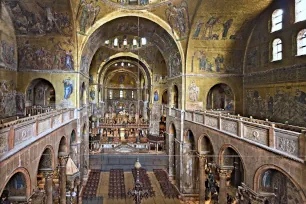
The basilica is laid out in a Greek cross design, and each arm has a central nave with side aisle. Its interior is even more spectacular than the building’s exterior. The magnificent marble floors are arranged in a geometric pattern with interspersed animal designs. About 8,000 square meters of gilded mosaics cover the walls and ceilings. Those completed in the twelfth century depict the New Testament, while those painted in the following century concentrate on the stories of the Old Testament. Also adorning the walls are the stories of the Virgin Mary, St. Peter, St. Clement, St. John the Evangelist, and – of course – St. Mark.
The canopy – or baldacchino – over the high altar is known as the Pala d’Oro, the Golden Pall. It is a panel of gold decorated with precious gems, sitting on columns decorated with 11th century reliefs. Byzantine goldsmiths were hired at the end of the tenth century to complete the work on this portion of the basilica, much of which is now protected by glass.
The Tesoro – or treasury – situated to the right of the main altar, contains many of the items taken from Constantinople as well as other relics the church has gathered over the years.
- Next: Grand Canal
- More Sights & Attractions in Venice

